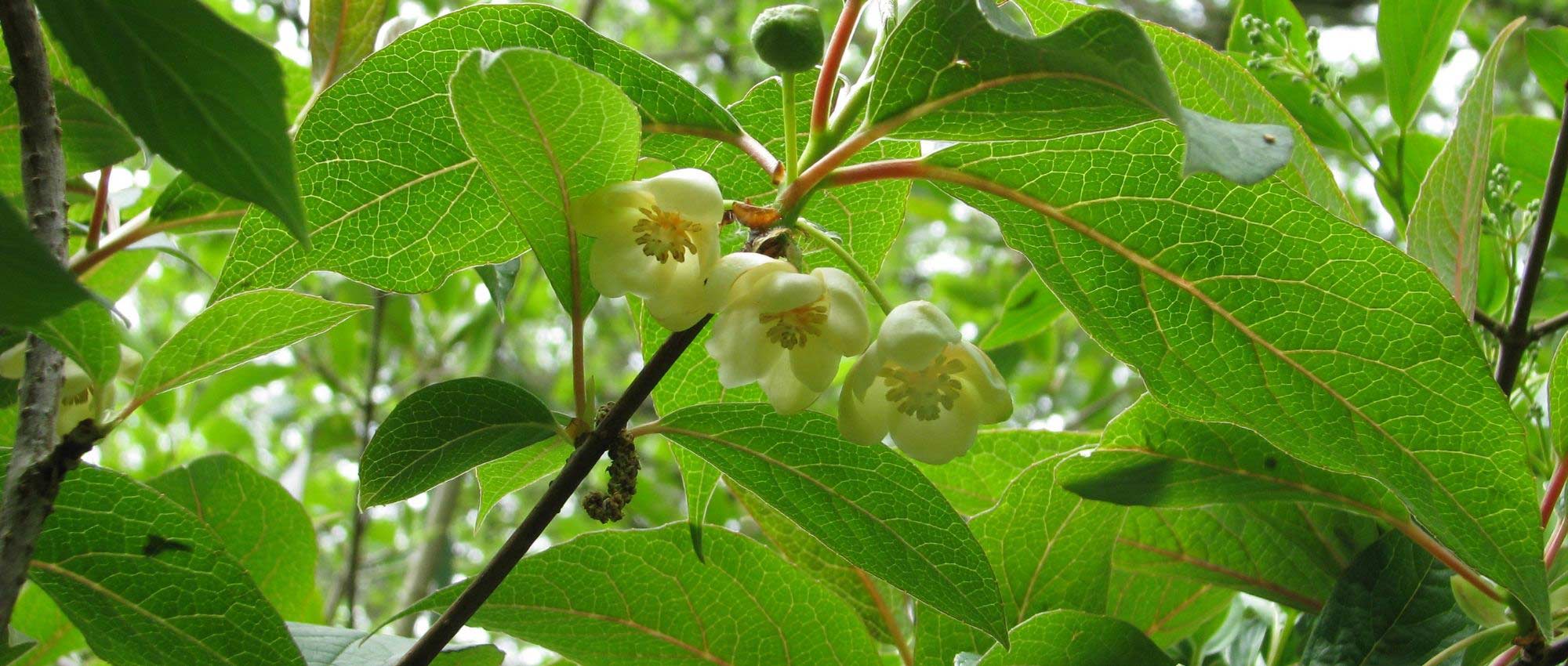
Schisandra: planting, berry harvest, maintenance
Contents
Schisandra in a nutshell
- Schisandra is a deciduous Asian liana, very hardy.
- It produces beautiful flowering, white or red, in late spring to early summer, then in autumn edible berries, described as “five‑flavoured”, with medicinal properties.
- It thrives in partial shade, sheltered from scorching sun, for example at the edge of woodland.
- It needs soil that stays cool and moist, as it is intolerant of drought.
- You can train it to climb trees! You can also guide it over a pergola or a trellis…
A word from our Expert
Schisandra is a climbing plant of Asian origin that produces attractive red or white flowers in late spring. They are followed by edible berries, sometimes nicknamed “five-flavour berries”, which have many medicinal properties and are used in traditional Chinese medicine. They are also very decorative, forming clusters of rounded fruits in a vivid red! In cultivation several species are found: notably Schisandra chinensis, the species most used for its berries, Schisandra grandiflora, which bears elegant white flowers, and Schisandra rubriflora, with red flowers. They are vigorous lianas that you can train to climb trees, or guide onto a pergola, a trellis… Schisandra remains undercultivated in gardens and is not very well known.
Schisandra prefers partial shade and must be sheltered from the sun during the hottest hours of the day. Although it appreciates good light and tolerates dappled sun, it needs shade at its base. It prefers soils that remain cool and do not dry out. It is hardy, tolerating between -15 and -25 °C, depending on varieties, which allows cultivation even in fairly cold regions. It requires very little maintenance. It is robust and vigorous and can reach up to 10 metres in height.
Botany
Botanical data
- Latin name Schisandra sp.
- Family Schisandraceae
- Common name Schisandra, Schizandra, five-flavour berry
- Flowering depending on variety, between May and July
- Height up to 10 metres
- Sun exposure partial shade
- Soil type fertile, rich in humus, fresh
- Hardiness between -15 and -20 °C
Schisandra are deciduous or evergreen climbing plants native to eastern Asia. Some 25 species occur in China, Myanmar, India and Mongolia. They sometimes grow in mountain areas, up to more than 2,000 metres altitude, which no doubt explains their excellent hardiness. The centre of diversity is in China, where berries of this liana have long been used for their medicinal properties. One species comes from the United States, Schisandra coccinea. In the wild, Schisandra grows in the understorey, on fresh soils, sometimes at the edge of waterways. Its voluble stems enable it to climb trees and bushes around it.
The Schisandra berry (notably S. chinensis) is also called the ‘five‑flavour berry’. It is sometimes spelled Schizandra. In English it is called Magnolia Vine.
Schisandra belongs to family Schisandraceae (formerly Illiciaceae). It is a small family, comprising only 73 species distributed across three genera: Illicium, Kadsura and Schisandra. Star anise (Illicium verum), an aromatic spice and medicinal plant, also belongs to this family. So does Kadsura japonica, an Asian climbing plant that can be mistaken for Schisandra and which also produces white flowers and red berries.
Schisandra is a voluble plant. It grows and twines its stems around supports by itself, allowing it to gain height. Under good growing conditions it can reach up to 10 metres, but it grows fairly slowly. Young shoots are green and tender, then become lignified, forming wood. They then take on an attractive reddish hue. Likewise, petioles and veins on the underside of the leaves are often reddish‑pink.
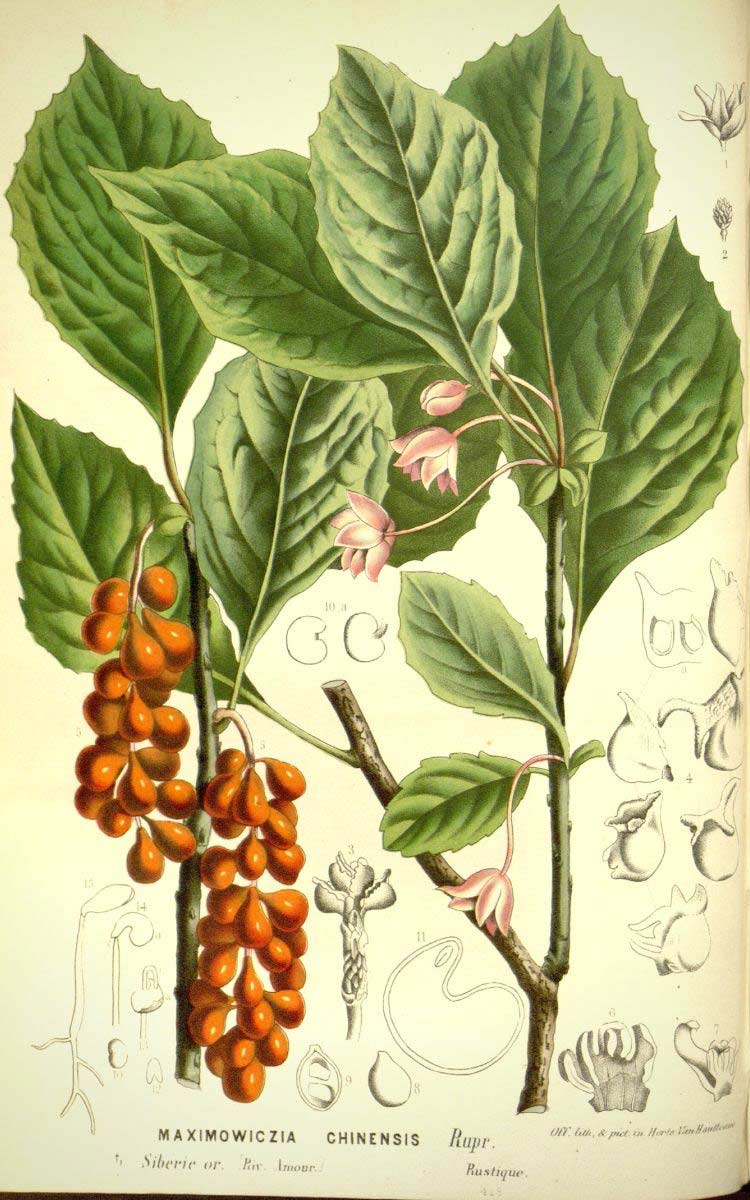
Schisandra chinensis: Botanical illustration
Schisandra leaves are simple, entire, generally ovate in shape, with the lamina edge sometimes dentate. They are fairly unremarkable. Leaves measure between 5 and 15 cm long and are arranged alternately along the stems, one after another.
Leaves of cultivated species are deciduous, falling in autumn with cold weather and reappearing in spring when temperatures become milder.
Flowering takes place in spring or early summer, between May and July depending on variety. Flowers may be strikingly red, as in Schisandra rubriflora, white, or even yellow (S. henryi). Schisandra grandiflora is notable for its elegant, highly fragrant white flowers. Flowers of Schisandra chinensis are also white but more discreet and smaller than those of other species, with thinner petals.
Flowers are borne on a long peduncle and are trailing, facing downwards. They may be solitary or grouped in clusters. They are axillary, inserted in the axil of the leaves. Flower buds are very rounded and open gently to reveal stamens or pistil. Petals are convex, concave. Flowers are very soft and delicate, cup‑shaped and measure up to 2–3 cm in diameter. Flowers bear between 5 and 12 tepals (undifferentiated sepals or petals), arranged in two ranks.
Flowers, particularly those of Schisandra grandiflora, are pleasantly fragrant.
Flowers are unisexual: either male or female. Male flowers bear stamens and release pollen that fertilises female flowers by settling on the pistil, allowing fruit to develop.
Schisandra is dioecious: there are male and female plants. Only female plants produce fruit. To obtain fruit, we recommend planting both male and female plants to ensure pollination.

Flowering of Schisandra chinensis, Schisandra grandiflora and Schisandra rubriflora
In late summer or early autumn, Schisandra produces fleshy, rounded, bright red berries. They are generally five or six millimetres in diameter. Berries are gathered in clusters and are very decorative. Clusters measure between 3 and 20 cm long. Each fruit contains between one and three seeds.
Fruits are harvested in early autumn, around September–October. Berries of Schisandra chinensis are mainly used. They can be eaten fresh but are usually dried. Called ‘five‑flavour berries’ for their sweet, bitter, salty, sour and spicy tastes, they are used to make juices, infusions and tinctures and can be added to salads. Commercially they are also available as capsules. They are used in Chinese medicine and are known as Wu Wei Zi.
Schisandra berries have many medicinal properties. They are adaptogenic and stimulating, help revitalise the body, improve resistance to stress and combat fatigue. They enhance endurance and physical and mental performance, and are said to have positive effects on memory and concentration. They are also considered aphrodisiac and may increase libido. Berries have a protective effect on the liver. Nutritionally, Schisandra berry is rich in vitamins, trace elements and amino acids and contains phytoestrogens. It should not be consumed by pregnant women.

Flowers and fruits of Schisandra chinensis (photos VoDeTan2 / Vladimir Kosolapov)
Main varieties of Schisandra
Most popular varieties
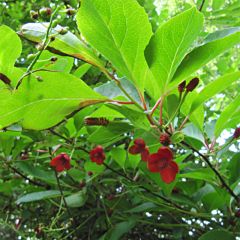
Schisandra chinensis
- Flowering time June, July
- Height at maturity 8 m
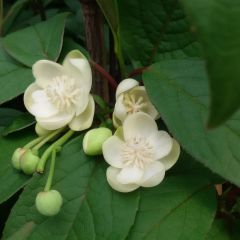
Schisandra grandiflora
- Flowering time June, July
- Height at maturity 6 m
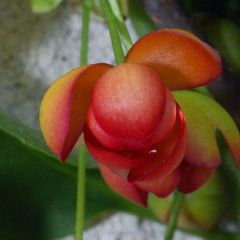
Schisandra rubriflora
- Flowering time June, July
- Height at maturity 3 m
Discover other Schisandra
View all →Available in 1 sizes
Available in 1 sizes
Available in 1 sizes
Available in 1 sizes
Planting Schisandra
Where to plant?
As Schisandra grows naturally in woodland understorey, best to position in partial shade. It likes to have at least its base in shade, and if possible the rest of the foliage in sun. You can also plant so it benefits from morning sun but is shaded during hottest hours of afternoon. Avoid scorching sun in all cases. Do not hesitate to place at woodland edge. That way you can easily let it climb into trees. A good option is also to grow against a wall, in a sheltered, shaded spot.
As it likes soils that remain cool, Schisandra will enjoy proximity to a pond or watercourse. Schisandra prefers cool, humus-rich, fertile, deep soils. It does not like dry, poor ground. Schisandra tolerates heavy, clay soils. It appreciates forest-type soils as found in understorey. It also has a preference for slightly acidic soil.
Schisandra is quite hardy, does not need winter protection, and can be grown even under a relatively cold climate, for example in mountainous regions.
You can train Schisandra to climb a trellis, into a tree, on a pergola, an arch, a summerhouse… It is also possible to train Schisandra on horizontally run wires. They can also climb a trellis against a wall. Give it a sufficiently large support. Bear in mind it can reach up to 10 m in height.
→ Discover how plant your schisandra in pot and how to prune and train schisandra in Pascale’s care sheets
When to plant?
Plant Schisandra preferably in spring, around May, or otherwise in autumn (September–October). We recommend planting in mild, slightly overcast weather, avoiding periods of frost or extreme heat.
How to plant?
To enjoy fruits of Schisandra, we recommend planting at least one male young plant and one female young plant, as this will allow pollination.
- Place rootball in a basin filled with water, to allow rehydration
- Dig a planting hole, two to three times the size of the rootball
- Place at bottom some soil mixed with well-rotted compost
- Place Schisandra in the planting hole.
- Replace soil all around rootball.
- You can install staking or a trellis, and guide its stems onto it.
- Water thoroughly.
In weeks following planting, continue to water regularly.
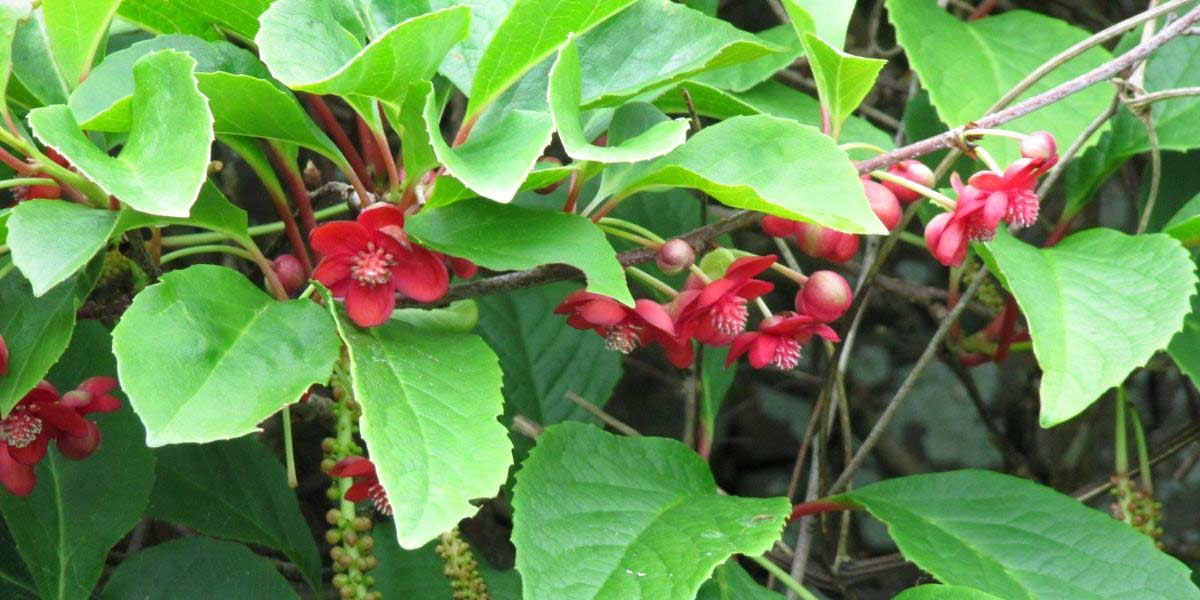
Schisandra rubriflora (photo Leonora Enking)
Care, berry harvest
Carry out regular watering, at least during planting year, as Schisandra is sensitive to drought. It is important that soil remains cool, even moist. We also recommend applying a layer of organic mulch around its base.
Don’t hesitate to add well-rotted compost to enrich soil. Indeed, Schisandra favours fertile soils rich in organic matter. Moreover, this will improve soil structure, increasing its water retention capacity.
Aside from these precautions, Schisandra requires very little maintenance. It is not very susceptible to diseases and pests, but may nevertheless be affected by powdery mildew.
Harvest of Schisandra berries takes place around September–October. You can eat them fresh or dry them to preserve and then use in infusions. You can also harvest berries to extract seeds and attempt sowing, but sowing is somewhat difficult to achieve.

Schisandra berries
Propagation
Schisandra can be multiplied by sowing or by propagation by cuttings. In any case, this liana is not easy to propagate and germination or rooting rate is fairly low. Furthermore, young plants obtained from sowing will take several years to produce berries. For propagation by cuttings of Schisandra, take either herbaceous cuttings in spring, around May–June, or semi-hardwood cuttings in late summer.
Sowing
You can sow Schisandra in spring, or in autumn using freshly harvested seeds.
Seeds are somewhat tricky to germinate. They require cold stratification, which you can carry out by placing them in the fridge before sowing. As germination rate is fairly low, we recommend sowing a larger number of seeds than you would for other plants.
- Prepare a pot with potting compost.
- Sow Schisandra seeds.
- Cover them with a thin layer of substrate, then press down gently.
- Water with a fine spray.
- Place the pot under a cold frame, in a bright spot but out of direct sunlight.
- Keep watering regularly so substrate remains moist but not waterlogged.
Association
As Schisandra likes shady positions and rich, cool soil, it will fit perfectly in an understorey garden. You can recreate a beautiful natural scene by planting beside it plants with decorative foliage, such as the ferns, Paris polyphylla, Brunnera macrophylla… Also enjoy the dense, groundcover foliage of Pachysandra! For their delicate flowerings, choose Geranium nodosum, corydalis, astrantias, Solomon’s seal, bleeding-heart… You can include grasses such as luzulas, carex, Hakonechloa macra… Also discover the superb Cornus canadensis, a groundcover dogwood offering large, beautiful white flowers formed of four bracts, and decorative foliage that turns red in autumn.
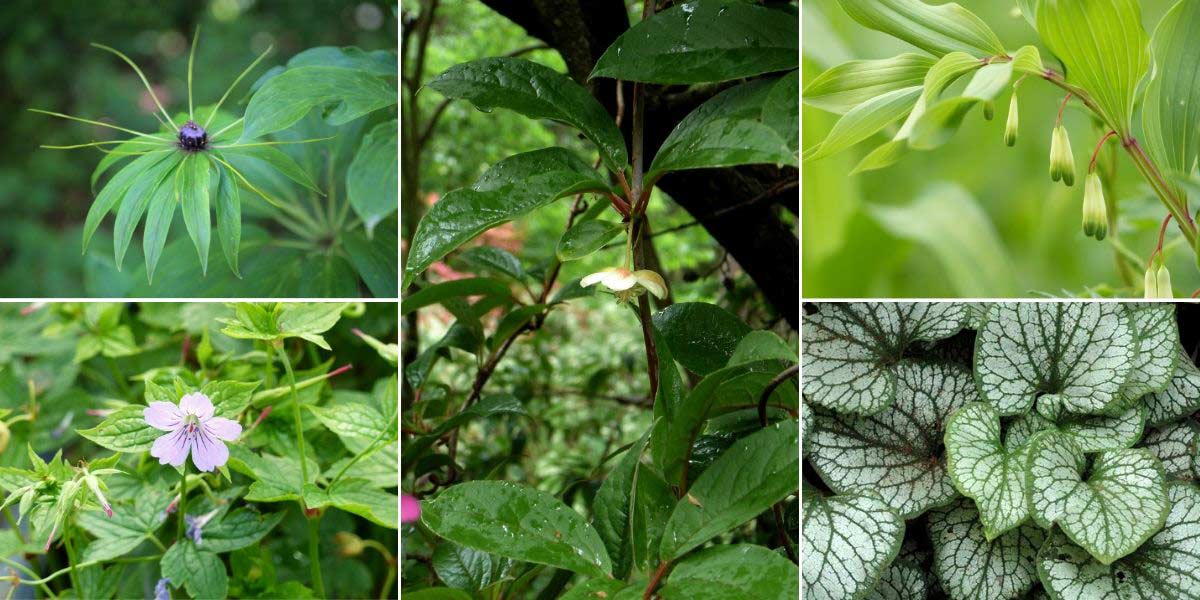
Schisandra is a liana that fits perfectly into understorey gardens! You can pair it with other plants that enjoy cool, shady conditions. Here, from left to right: Paris polyphylla, Geranium nodosum, Schisandra grandiflora (photo Peganum), Polygonatum odoratum, and Brunnera ‘Jack Frost’
You can also pair Schisandra with other climbing plants. Discover, for example, Akebia quinata, which offers pretty, finely divided, light-green foliage and an unusual spring flowering. Its berries are edible! You can also plant clematis, which, like Schisandra, appreciate having their base in shade while the rest of the foliage is in sun. Also discover Kadsura japonica, another Asian climbing plant in the same vein as Schisandra.
You can associate Schisandra with trees and bushes on which it can climb. Plant it at the base of a fruit tree and let it climb into the canopy. Also take advantage of fruit-bearing bushes! You can pair it with persimmon, pawpaw, raspberries, mulberries, blue honeysuckle, Lycium barbarum (which produces goji berries!)… Combine it with plants that, like it, produce unusual, medicinal and highly nutritious berries.
Feel free to plant perennials at its base. This will also help shade the base of Schisandra and keep soil cool – everything it needs! Enjoy, for example, hardy geraniums, heucheras or hostas…
Useful resources
- Discover our range of Schisandra
- Schisandra on the Plantes et botanique website, with extensive botanical information on the different species
Frequently asked questions
-
Several causes possibles — et solutions pratiques — pour un Schisandra qui ne fructifie pas ou peu. Voici un guide pour diagnostiquer et corriger le problème. Causes fréquentes - Plante dioïque (séxuation) : Schisandra chinensis est généralement dioïque — il faut plantes mâles et femelles pour obtenir des baies. Si vous n’avez que des pieds d’un seul sexe, pas de fruits. - Jeune plant : la production commence souvent à partir de 3–4 ans, parfois plus tard selon conditions de culture. - Pollinisation insuffisante : besoin d’insectes pollinisateurs (abeilles…). Peu d’insectes ou temps froid/pluvieux pendant la floraison réduisent la fécondation. - Exposition / luminosité insuffisante : trop d’ombre limite la floraison et la maturation des fruits. - Taille mal conduite : taille sévère au mauvais moment peut supprimer bois à fleurs. - Excès d’azote : engrais riche en azote favorise le feuillage au détriment des fleurs/ fruits. - Stress hydrique ou sols pauvres : sécheresse ou sol compact/ pauvre en humus limitent la fructification. - Gel tardif ou dommages aux bourgeons floraux : gel de printemps peut détruire fleurs/bourgeons. - Problèmes phytosanitaires ou ravageurs : très rarement, mais maladies ou dégâts d’insectes peuvent réduire la mise à fruit. Que vérifier rapidement 1. Sexe de la plante : identifiez si pied mâle et femelle sont présents. Si doute, contactez vendeur/observez fleurs (mâles souvent en grappes, femelles donnent ovaires). 2. Âge de la plante : moins de 3 ans ? patience nécessaire. 3. Emplacement : exposition (préférer soleil matin et mi-ombre l’après-midi), drainage, niveau d’humidité. 4. Engrais utilisé : apportez-vous beaucoup d’azote ? 5. Moment et façon de tailler : taille tardive au printemps ou hiver dernier a-t-elle été trop sévère ? 6. Conditions météo pendant floraison : gel, pluie froide, orages ? Remèdes et bonnes pratiques - Assurer présence de mâle(s) : planter au moins 1 pied mâle pour 4–8 pieds femelles, ou rapprocher un plant mâle existant. - Améliorer pollinisation : favoriser pollinisateurs (fleurs couvre-sol, lavande, sauges), éviter insecticides au moment de la floraison, ou polliniser à la main avec un petit pinceau si nécessaire. - Ajuster exposition : déplacez plante en station plus lumineuse si possible (supporte mi-ombre mais fructifie mieux avec plus de soleil). - Fertilisation équilibrée : éviter excès d’azote. Appliquer compost bien mûr au printemps et un engrais riche en P et K avant floraison pour favoriser floraison et fructification. - Arrosage régulier : maintenir sol frais mais bien drainé, surtout en période de fructification. Pailler pour garder humidité et enrichir sol. - Taille au bon moment : tailler léger après récolte (éviter taille sévère avant ou pendant floraison). Ne pas supprimer bois à fruits. - Protéger contre gel tardif : abriter jeunes bourgeons si gel prévu (voile d’hivernage au printemps si nécessaire). - Vérifier état sanitaire : traiter problèmes spécifiques s’il y en a. Actions concrètes à court terme (prioritaires) 1. Vérifiez sexe de vos plants — si seule présence de femelles, plantez un mâle à proximité. 2. Si plante < 3–4 ans, attendez une saison ou deux tout en optimisant exposition, eau et sol. 3. Réduisez engrais azoté ; apportez compost et PK au printemps. 4. Attirez ou facilitez pollinisateurs ; en dernier recours, pollinisez à la main pendant la floraison. Si vous voulez, donnez quelques détails (âge de la plante, exposition, si vous avez un pied mâle/femelle, type de sol et d’engrais utilisé) et je vous proposerai un diagnostic et un plan d’action plus précis.
First of all, Schisandra is a dioecious plant: only female young plants can produce fruit. And to do so, they need to be pollinated by male young plants. Therefore, to obtain fruit we recommend planting several young plants of both sexes.
Next, perhaps conditions are not optimal for Schisandra: it needs rich, humus-bearing, moist soil, and berries develop better with good light and a little sun. If your ground is poor and dry, or shade is too dense, Schisandra will struggle to bear fruit. Don't hesitate to add organic matter and mulch around the base.
Finally, perhaps your young plant is still too young. When obtained from sowing, young plants need at least three to four years before they start to bear fruit. Be patient.
- Subscribe!
- Contents
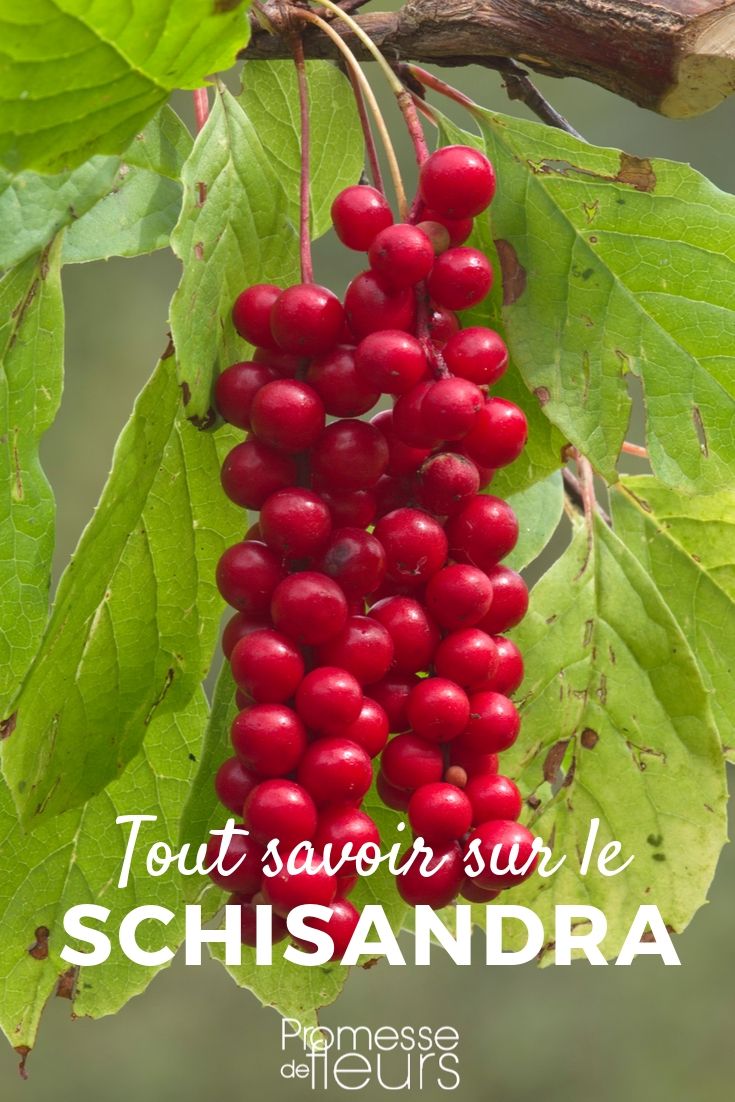
































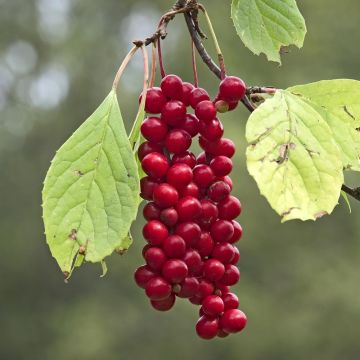


Comments